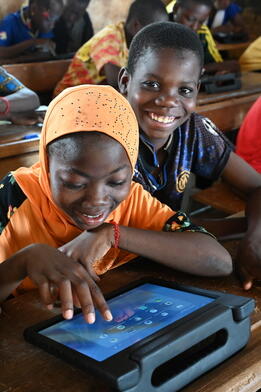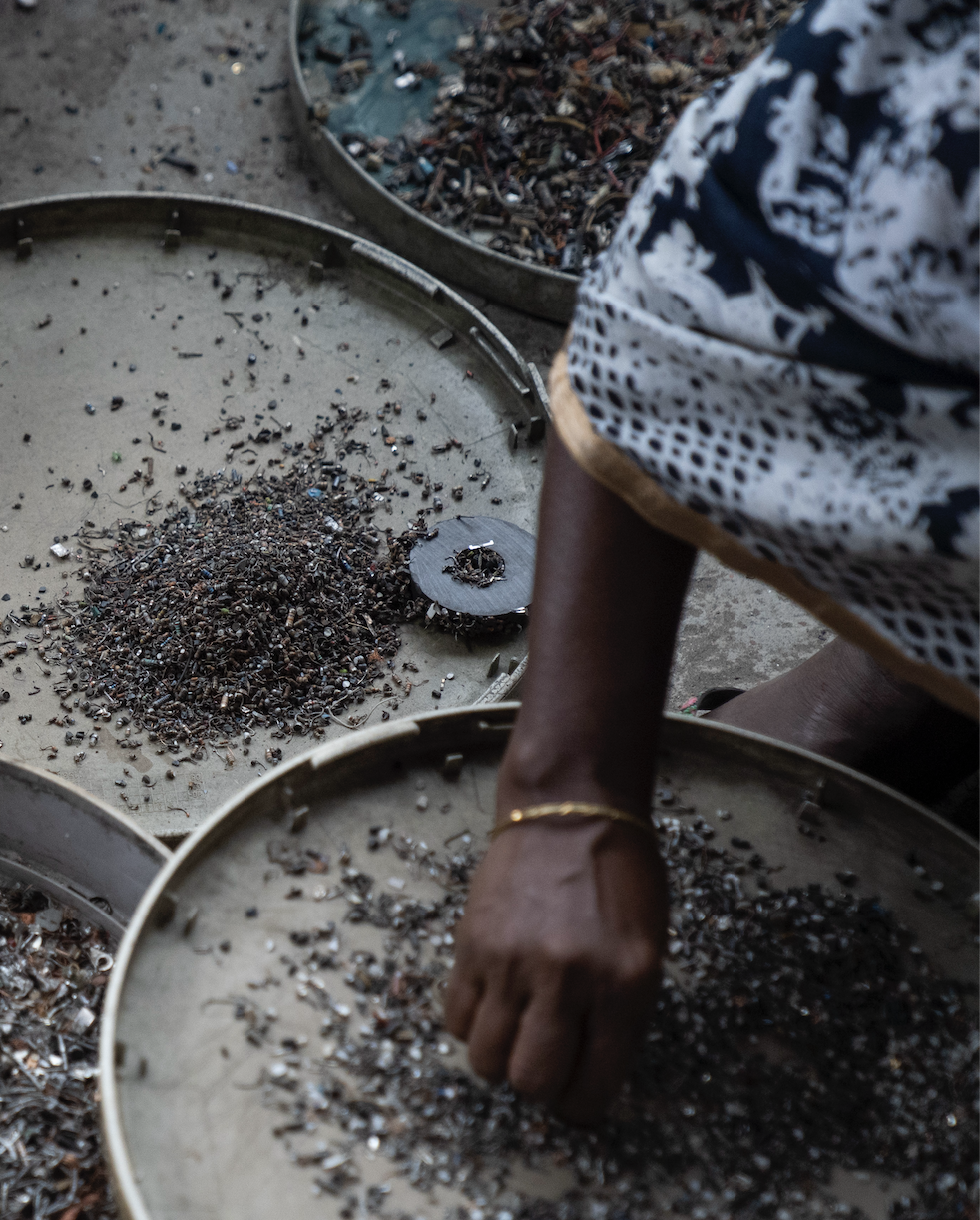E-waste
The problem
E-waste is defined as any "electrical or electronic equipment, which is waste, including all components, subassemblies, and consumables, which are part of the equipment at the time the equipment becomes waste.”
E-waste includes items such as discarded computers, televisions, mobile phones and tablets, as well as larger electrical appliances, that contain mixtures of valuable materials (i.e., gold, silver, platinum, palladium, etc.) and hazardous toxicants that are released into the environment. It is estimated that e-waste is responsible for approximately 70 per cent of reported hazardous toxicants in the environment. The main categories of pollutants emitted are heavy metals (i.e., lead, cadmium, mercury), persistent organic pollutants (POPs), airborne particulate matter (PM2.5), and polycyclic aromatic hydrocarbons (PAHs).
The growing e-waste is fueling a health crisis for children in low- and middle-income countries, where 90 per cent of exported e-waste is processed. According to the WHO Digital Dumpsites report, millions of children, adolescents and women of childbearing age work at informal e-waste processing sites where they are exposed to dangerous chemicals and waste that are hazardous to their health and development.
+18
million
Children work in industries related to waste processing – with e-waste a subsector of this industry.
We throw out three e-waste objects for every newborn
Children's unique vulnerability

- Children are closer to the ground: This can expose them to toxicants such as lead and mercury from e-waste, which has the highest concentration at ground level.
- Children tend to spend more time outdoors than adults: Outdoor play can expose them to toxicants from nearby e-waste sites.
- Hand-to-mouth/object-to-mouth exposures: These may result in the ingestion of e-waste contaminants in the soil, dust or transferred from surfaces. Children with pica are at an even higher risk.
- Anabolic and rapidly growing: E-waste can contaminate food, water, and air; children ingest more food and water and breathe more air relative to their size than adults.
- Immature central nervous systems: Infancy and childhood are critical periods of neurodevelopment, when neuronal growth, differentiation, migration, synaptogenesis, and myelination take place. E-waste contains multiple known or suspected neurotoxicants, such as lead and mercury, which may disrupt the normal development of the central nervous system during the prenatal period, infancy, childhood and adolescence.
- Immature respiratory system: Some harmful toxicants from e-waste may impact the structural development and function of the lungs. While alveolar development is mostly complete by 2 years of age, lung growth continues through adolescence and parallels somatic growth. It is thought to be complete by approximately 18 years of age in females and 20 to 23 years of age in males. Until adult systems are fully developed, exposures to air pollution may alter function in reversible and irreversible ways.
- Other: E- waste may also lead to permanent changes in the immune system and thyroid function.
- Children have longer life expectancies than adults: Chronic conditions developed in childhood can affect their entire lifetime. For diseases with long latency periods, the effects of exposure to pollutants released through e-waste recycling activities may not manifest for many years.
- Young children do not know to stay away from e-waste recycling sites, and the youngest children lack the agency to move away at all: Children may play in dumps and landfills, accidentally exposing themselves to toxic e-waste. Children may not stop an activity if they are experiencing ill health or injury from e-waste activities.
Health impacts on children
Sources of exposure
Children face the harmful effects of e-waste from different sources of exposure:
- Occupational exposure in waste sites.
- Exposure in home settings and via family members.
- Community environmental exposure.
Routes of exposure
Children could be exposed to harmful chemicals in e-waste via:
Children can ingest e-waste toxicants from food, water, breast milk, soil, and dust, as well as dust-contaminated objects such as toys and surfaces.
Children may inhale particles and aerosol gases and particulate matter from open burning, making children especially vulnerable to e-waste compounds that are burned, heated, or result from chemical reactions.
Several corrosive chemicals can be deposited on children's skin. Specific contaminants can also enter the body through the skin when children are injured.
When pregnant, mothers can pass on to the fetus contaminants that they have either ingested, inhaled, or received through dermal exposure. The findings of various studies have shown that many e-waste hazardous elements, such as lead, cadmium, mercury, arsenic, zinc, flames retardants, PCBs, phthalates, phenols, and PFAS, can cross the placenta.
Through these varying sources and routes of exposure, children are strongly affected by e-waste contaminants. Based on a systematic review, there is a link between e-waste exposure in children and decreased childhood lung function, reduced thyroid function, altered cellular expression and function, adverse neonatal outcomes and negative changes in children's temperament and behaviour.

Children and digital dumpsites: E-waste exposure and child health
This report summarizes the latest scientific knowledge on the links between informal e-waste recycling activities and health outcomes in children. As many as 18 million children and adolescents and 12.9 million women, including an unknown number of women of childbearing age, may be at risk from adverse health outcomes linked to e-waste recycling. The report is intended to increase awareness and knowledge among health professionals of the dangers that e-waste recycling poses to the health of future generations and is a call to action to reduce children’s exposure to harmful e-waste activities.
Tips for caregivers
- Adopt a sustainable lifestyle, which includes reducing, reusing and recycling electrical and electronic equipment.
- Avoid bringing hazardous substances home by following safety and health protocols.
- Ensure that children and pregnant women are not exposed to e-waste sites.
- Learn what happens to e-waste in the community and advocate to ensure that it is safely managed.
- Advocate for the right to repair electrical and electronic equipment with manufacturers and policymakers.
- Empower children and adolescents to be a part of the solution to prevent and reduce e-waste as electronic consumers.
What partners can do
Establish children’s environmental health surveillance and monitoring systems
that include indicators related to hazardous e-waste.
Develop and improve national legislation and enforcement
to create a robust e-waste management system based on extended producer responsibility or the “polluter pays” principle.
Provide adequate resources and financing
for environmentally sound e-waste management including safe collection, segregation, recycling and disposal.
Regulate industry to incentivize responsible manufacturing
of electronics, using safer and less toxic materials and take-back mechanisms.
Incorporate informal e-waste workers into the formal economy
providing training, protective equipment and other measures to ensure occupational safety, especially for pregnant women.
Work with schools to actively prevent and respond to child labour
by engaging with at-risk youths and families.
Develop and expand children’s environmental health capacities
within Ministries of Health and Environment to address concerns related to e-waste exposure.
Improve the capacity of paediatric and primary health care
to detect and diagnose children’s illnesses related to e-waste and raise awareness among health professionals and the general public of this pollution concern.
Create systems in health care facilities and poison centres
to monitor and treat children and pregnant women who are exposed to environmental risks such as e-waste.
Research and contribute to existing knowledge
on the health impacts of pregnant women and children who are involved in the e-waste sector.
Build evidence through research
on the health, economic and environmental impacts of e-waste.
Advocate for legislation
on the environmentally sound management of e-waste.
Inform and educate
the general public on the health and environmental impacts of e-waste.
Manufacture sustainable and long-lasting
electrical and electronic equipment.
Substitute hazardous components
for safer alternatives where possible.
Take on extended producer responsibility
to include sound e-waste management and take-back mechanisms that properly recycle equipment.
Invest in repairing, recycling and reusing
within manufacturing and supply chains, rather than mining virgin materials.
Raise awareness with employees and in communities
on responsible consumption and environmentally sound waste management.